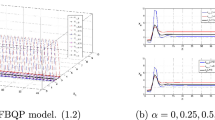Abstract
At present time, new advances in the generation of computational models can be applied to improve tasks in different areas of research. The hybrid computational models can be considered as new advances in science. In the present work a hybrid model has been proposed on the basis of a cellular automata and fuzzy logic to simulate, in space and time, the dynamics of a population structured by ages and where the changes in the levels of the biomass are induced by a stochastic variation of the environment. The model can be used as computational tool in the area of the Biology to describe and quantify the changes that continuously occurs in the population, knowing not only their size and its structure, but the form and the intensity in which it changes and renews.
Access this chapter
Tax calculation will be finalised at checkout
Purchases are for personal use only
Preview
Unable to display preview. Download preview PDF.
Similar content being viewed by others
References
Anderson, J.R.: The architecture of cognition. In: Cognitive sciences series. Harvard University Press, Cambridge (1983)
Czárán, T.: Spatiotemporal Models of Population and Community Dynamics. Chapman & Hall, London (1998)
Di Stefano, B., Fuks, H., Lawniczak, A.T.: Application of fuzzy logic in CA / LGCA models as a way of dealing with imprecise and vague data. Electrical and Computer Engineering, Canadian Conference 1, 212–217 (2000)
Fortuna, L., Rizzotto, G., Lavorgna, M., NunnarI, G., Xibili, M.G., Capponetto, R.: Soft Computing. In: New trends and Applications. Springer, Heidelberg (2001)
Gutiérrez, J.D., Riss, W., Ospina, R.: Lógica difusa como herramienta para la bioindicación de la calidad del agua con macroinvertebrados acuáticos en la sabana de bogotá – colombia Caldasia. 26(1), 161–172 (2004)
Mandelas, E.A., Hatzichristos, T., Prastacos, P.: A fuzzy cellular automata based shell for modelling urban growth – a pilot application mesogia area. In: 10th AGILE International Conference on Geographic Information Science Alborg University, Denmark (2007)
Molina-Becerra, M.: Análisis de algunos modelos de dinámica de poblaciones estructurados por edades con y sin difusión, PhD Thesis, España Universidad de Sevilla (2004)
Molofsky, J., Bever, J.: A new kind of ecology? BioScience 54(5), 440–446 (2004)
Moreno, N., Ablan, M., Tonella, G.: SpaSim: A software to Simulate Spatial Models. Integrated Assessment and Decision Support. In: Proceedings of the First International Environmental Modeling and Soft-ware Conference, Vol 3. pp. 348–358. June 24-27. Lugano, Switzerland (2002); ISBN 8890078707
Leal, R.C.: Desarrollo de un simulador, basado en un autómata celular, para la generación de dinámica poblacional inducida por gradientes de favorabilidad ambiental, Ms. Thesis, Universidad Autónoma de Baja California (2004)
Rohde, K.: Cellular Automata and Ecology, Zoology, University of New England, Armidale NSW 2351, Australia (2005)
Von Bertalanffy, L.: A quantitative theory of organic growth. Hum. Biol. 10(2), 181–213 (1938)
Von Neumann, J.: Theory of Self-reproducing Automata. University of Illinois Press, Urbana (1966)
Wolfram, S.: Theory and Applications of Cellular Automata. World Scientific, Singapore (1986)
Zadeh, L.A.: The concept of a linguistic variable and its application to approximate reasoning, Parts 1, 2, and 3, Information Sciences (1975)
Zadeh, L.A.: Fuzzy Logic. Computer 1(4), 83–93 (1988)
Author information
Authors and Affiliations
Editor information
Rights and permissions
Copyright information
© 2008 Springer-Verlag Berlin Heidelberg
About this chapter
Cite this chapter
Ramírez, C.L., Castillo, O. (2008). A Hybrid Model Based on a Cellular Automata and Fuzzy Logic to Simulate the Population Dynamics. In: Castillo, O., Melin, P., Kacprzyk, J., Pedrycz, W. (eds) Soft Computing for Hybrid Intelligent Systems. Studies in Computational Intelligence, vol 154. Springer, Berlin, Heidelberg. https://doi.org/10.1007/978-3-540-70812-4_11
Download citation
DOI: https://doi.org/10.1007/978-3-540-70812-4_11
Publisher Name: Springer, Berlin, Heidelberg
Print ISBN: 978-3-540-70811-7
Online ISBN: 978-3-540-70812-4
eBook Packages: EngineeringEngineering (R0)




